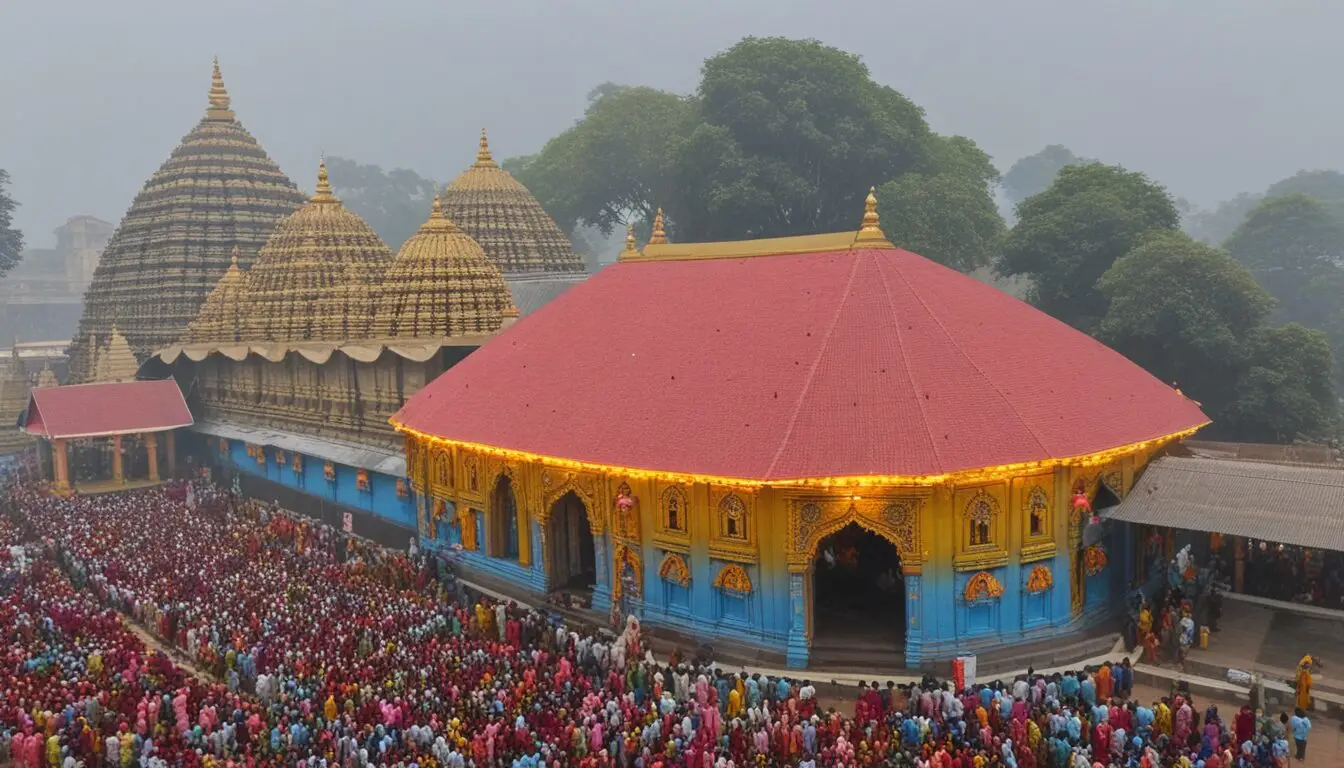
Priest’s Note: This teaching belongs to our Kamakhya GuidePedia. Seek more wisdom in the sacred navigation [🕉️ Kamakhya Temple GuidePedia Navigation 🕉️] below ↓↓↓↓.
Hey, travel fam! Ever wondered about a place where ancient heartbreak blossomed into divine power? Where goddess worship takes on a uniquely vibrant, profoundly feminine form? Well, let me take you on a journey to the mystical heart of Guwahati, Assam, nestled atop the serene Nilachal Hills: the legendary Kamakhya Temple. 🌄

This isn’t just a temple; it’s a living, breathing testament to eternal love, cosmic grief, and the fierce power of the divine feminine. Get ready to dive deep into a story that will stir your soul and ignite your wanderlust! For a comprehensive guide to planning your visit, check out our Unlock the Secrets of Kamakhya Temple: Ultimate Guide to Visit Planning!
The Legend: A Tale of Love, Loss, and Cosmic Creation 💖
At the core of Kamakhya’s existence lies one of Hindu mythology’s most poignant sagas – the story of Sati and Shiva. Imagine a love so profound, it threatened to unravel the very fabric of the universe.
- Sati’s Sacrifice: Sati, deeply in love with Lord Shiva, was humiliated when her father, King Daksha, deliberately insulted Shiva at a grand yagna (fire sacrifice). Unable to bear the insult to her beloved, Sati self-immolated in the sacrificial fire. 🔥
- Shiva’s Devastation: Overwhelmed by grief, Shiva cradled Sati’s lifeless body and performed the Tandava, the cosmic dance of destruction. His sorrow was so immense, it shook the heavens and the earth.
- The Birth of Shakti Peeths: To save the universe from Shiva’s uncontrollable rage, Lord Vishnu used his Sudarshana Chakra to dismember Sati’s body. Wherever a part of her body fell, a Shakti Peeth – a seat of divine power – was created. 🙏 To learn more about this divine connection, read about Kamakhya Temple and the Magic of the Shakti Peethas.
- Kamakhya: The Yoni Peeth: And right here, on the Nilachal Hills, Sati’s yoni (womb or reproductive organ) fell. This makes Kamakhya Temple the most revered and potent of all Shakti Peeths, celebrating the very source of creation and the divine feminine. It’s truly the epicenter of Shakti. ✨
It’s a story that beautifully intertwines heartbreak with the very essence of creation, reminding us that even in profound loss, new life and power can emerge.
A Glimpse Inside: Where the Goddess Lives & Breathes 🌟
Unlike most Hindu temples that house an idol, Kamakhya is unique. Here, you won’t find a sculpted image of the Goddess. Instead, within the darkened sanctum, there’s a natural spring that flows from a yoni-shaped stone. This is the living Goddess, perpetually worshipped. 💦
The temple’s architecture, a unique blend of traditional Nagara and Saracenic (Mughal) styles known as the Nilachala type, is a visual feast. As you approach, you’ll notice the intricately sculpted exterior, adorned with figures, including a striking Lord Ganesha sculpture often smeared with bright red vermilion. During festivals like Navratri, the temple transforms into a riot of colors, beautifully decorated with vibrant flowers, especially red ones, symbolizing the Goddess’s power. 🌺 For a deeper dive into its design, explore the Unique Architecture & Intriguing Symbolism of the Kamakhya Temple.
The air around Kamakhya is thick with devotion, incense, and the chants of pilgrims. While the queues can be long (more on that later! 😉), the spiritual energy is palpable. You’ll witness devout pujaris performing ancient rituals, and the sense of stepping into a timeless space is truly awe-inspiring.
The Ambubachi Mela: Mother Earth’s Annual Cycle 🌍🩸
One of the most fascinating and unique aspects of Kamakhya is the annual Ambubachi Mela, usually held in June. This isn’t just a festival; it’s a celebration of Mother Earth’s fertility.
- Goddess Menstruates: It’s believed that during these days, Goddess Kamakhya, symbolizing Mother Earth, undergoes her annual menstrual cycle.
- Temple Closes: The temple doors are closed for three days, allowing the Goddess to rest and rejuvenate.
- A Symbol of Fertility: Devotees believe that during this period, the creative and nurturing power of the Goddess is at its peak.
- Unique Prasad: After the temple reopens, devotees receive Angodak (sacred water) and Angabastra (a small piece of red cloth believed to have been touched by the Goddess during her menstruation). This is considered incredibly auspicious.
It’s a powerful affirmation of the divine feminine’s ability to create, sustain, and regenerate, a truly unique tradition found nowhere else. You can learn more about this powerful event in our article on Ambubachi Mela at Kamakhya Temple: The Most Powerful Festival in Assam.
History & Heritage: Rising from the Ashes of Time 🕰️
The story of Kamakhya is also one of resilience. While ancient texts suggest a temple stood here as early as 200 BCE, the current structure has seen its share of destruction and rebirth. For a detailed account, check out the Enigmatic Legends and Wonderful History of Kamakhya Temple.
- Ancient Roots: Evidence points to an early temple around the 8th century CE, possibly by the Pala dynasty.
- Kalapahar’s Fury: The temple was famously destroyed in the 16th century by the invading Muslim commander Kalapahar.
- Rebirth by Koch Kings: But divine power cannot be suppressed! The current magnificent structure was rebuilt by King Naranarayana of the Koch dynasty in the mid-16th century. His architect, Meghamukdam, even tried to rebuild the dome with original stone blocks before settling on a beehive-shaped brick dome.
- Ahom Contributions: Later, the Ahom dynasty also contributed significantly to the complex, adding more temples and shrines.
Today, the scattered sculpted stones around the Nilachal Hills stand as silent witnesses to the temple’s enduring legacy and architectural evolution.
Your Kamakhya Journey: Tips for a Seamless Visit 🚶♀️🎒
Ready to experience this divine energy for yourself? Here are a few tips to make your visit meaningful:
- Darshan Timings: The temple generally opens around 5:30 AM and closes by 5:30 PM, with a short break in the afternoon. Arrive early (like, really early, especially on weekends or during festivals!) to beat the queues. ⏰
- Queue Management: There are different entry options:
- Free Entry: This queue can be very long, sometimes hours, or even half a day.
- Special Entry Ticket: A quicker option for a nominal fee, this usually involves a comparatively shorter wait.
- Direct/VIP Entry: For a higher fee, some pujaris might offer direct entry, but be mindful of the commercial aspect.
- What to Wear: Modest clothing is recommended. Cover your shoulders and knees. Remember, you’re entering a sacred space. For detailed guidance, read Know How To Dress To Visit Kamakhya Temple. 🙏
- Offerings: You can buy flowers (especially red hibiscus), sindoor, and saris outside the temple. Coconuts and fruits are also common offerings.
- Photography: Strictly prohibited inside the temples on Kamakhya Hill. Any photos you see online of the inner sanctum are not genuine. So, soak it all in with your eyes and heart! 🚫📸
- Local Vibes: The path leading to the temple is vibrant, with many shops selling souvenirs, prasad, and local delights. Take some time to explore them! 🛍️😋
- Best Time to Visit: October to March offers pleasant weather. Avoid the peak Ambubachi Mela if you’re not specifically attending the rituals, as crowds are immense. You can check the official Kamakhya Temple website for the latest visitor guidelines and timings.
While the experience can be bustling, remember the profound spiritual journey you’re undertaking. It’s a place to connect with the raw, untamed power of the divine feminine.
Beyond the Temple: Exploring Guwahati 🌆
Your spiritual journey at Kamakhya can easily extend to exploring more of Guwahati! Consider:
- Cruising the Brahmaputra: Take a majestic river cruise on the mighty Brahmaputra. 🚢
- Umananda Temple: Visit this Shiva temple located on a river island, often called the smallest inhabited riverine island in the world. 🐒 Learn more about this unique spot in our Ultimate Guide to Umananda Island: The most unique River Island.
- Assam State Museum: Dive deeper into the region’s rich history and culture. 🏛️ Find out what to expect in Drifting in Time: Assam State Museum’s Most Fascinating Guides.
- Taste Local Flavors: Don’t leave without trying some authentic Assamese cuisine! 🍛 Check out our guide to the 5 Best Places for Authentic Assamese Cuisine to find your next meal.
For more information on the temple and its significance, you can refer to academic resources like the Sanskriti Portal or articles on the history of Kamakhya Temple on Wikipedia.
Looking for more hidden gems in the Northeast? Don’t miss our guides on Exploring Kaziranga National Park 🐘 and the Mystical Majuli Island 🏞️ for your next adventure!
Kamakhya Temple is more than just a pilgrimage site; it’s a powerful narrative of cosmic proportions, a celebration of womanhood, and a unique cultural experience that will stay with you long after you leave. So, when are you planning your trip to witness this divine magic? ✨✈️
🕉️ Kamakhya Temple GuidePedia Navigation 🕉️
Your complete guide to the sacred temple
🛕 Temple Guide 🛕
🏛️ Attractions 🏛️
🏨 Accommodation 🏨
🍽️ Food & Dining 🍽️
✨ Spiritual Secrets ✨
🚗 Guwahati → 5 Gems 🚗
🙏 Explore the divine journey through Kamakhya Temple 🙏


